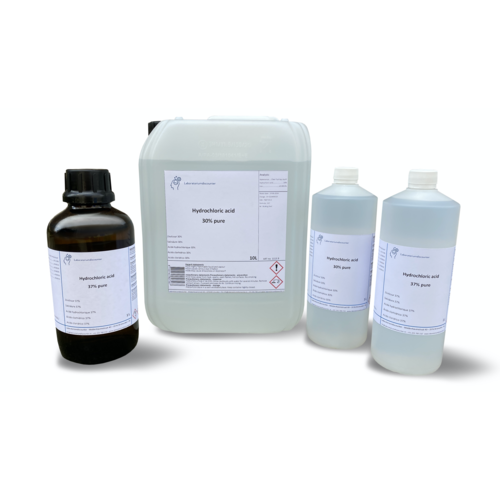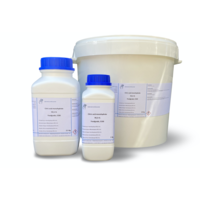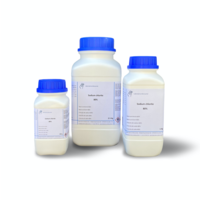You have no items in your shopping cart
Hydrochloric acid
- Buy 2 and save 3%
- Buy 6 and save 5%
What is hydrochloric acid?
Hydrochloric acid, also known as salt spirit, is an aqueous solution of gaseous hydrogen chloride, which is protolyzed to oxonium and chloride ions. It is a strong, inorganic acid and is one of the mineral acids. Their salts are called chlorides, the best known being sodium chloride (NaCl, table salt).
What is hydrochloric acid used for?
Hydrochloric acid is an important basic chemical that is of great importance in the chemical industry as an inorganic acid. For example, it is used in the processing of ores and rock phosphate. It is used to boost petroleum and natural gas probes, especially in carbonate deposits, but also in sandstone deposits. With their help there are also z. B. Removed limescale on equipment and cleaning after drilling with filter gravel ("Grindpack") and on drill holes themselves. In metal processing it is used for pickling, etching and soldering. In addition, diluted hydrochloric acid is used in construction to remove mortar residues from masonry - so-called acidification.
Last but not least, hydrochloric acid is an important reagent in chemical analysis. It is able to separate a group of metals, which form poorly soluble chlorides, from other metals by precipitation. These can then be further analyzed individually (see hydrochloric acid group). Alkalimetry is another field of application for hydrochloric acid.
In the pharmaceutical industry, hydrochloric acid is used to convert basic drugs that are poorly or insoluble in water (examples: ciprofloxacin, citalopram, clenbuterol, clindamycin, dibenzepine) into more soluble hydrochlorides.
One of the main uses of hydrochloric acid is in steel pickling to remove rust or iron oxide scale from iron or steel prior to subsequent processing, e.g. B. by extrusion, rolling, electroplating and other techniques.
Hydrochloric acid regeneration processes have been developed in the steel pickling industry, such as the spray burner or the fluidized bed HCl regeneration process, which make it possible to recover HCl from used pickling liquor. The most common regeneration process is the pyrohydrolysis process.
By recovering the used acid, a closed acid cycle is created. The iron oxide by-product of the regeneration process is valuable and used in various secondary industries.
In normal acid-base reactions, hydrochloric acid can be used to produce a variety of products that lead to inorganic compounds. These include water treatment chemicals such as ferric chloride and polyaluminium chloride.
Both iron(III) chloride and polyaluminium chloride are used as a flocculant in wastewater treatment, drinking water production and papermaking.
Other inorganic compounds produced with hydrochloric acid include calcium chloride as road salt, nickel(II) chloride for electroplating, and zinc chloride for electroplating and battery production.
buy hydrochloric acid?
You can buy hydrochloric acid of the best quality at Laboratoriumdiscounter.nl. Available in different concentrations and packaging. Delivered quickly and for a friendly price!
What Safety Precautions Should I Take Before Using Chemicals?
It is always wise to work as safely as possible when working with chemicals. Even substances that do not seem dangerous at first can cause enormous damage if they get into your eyes. Therefore, always wear safety goggles. You also want to prevent chemicals from ending up on your skin, which is why it is important to always use good gloves or disposable gloves.
Respiratory protection is necessary for volatile substances, vaporous liquids and solids that dust. There are many different types of filters, so you should always refer to the MSDS to find out which filter you need. Many filters also specify which substances they are for.
In some cases it may be necessary to protect the whole body, in which case a plastic overall is needed, you can find it here.
When working with flammable and oxidizing substances, it is important to always have fire extinguishers and absorbents at hand. It is also useful to be able to clean up spills of aggressive chemicals immediately with absorbents and to dispose of them in accordance with international and/or local legislation.
If you need more information on how to handle a specific substance, always consult the safety data sheet. You can find this on the product page or request it via [email protected]
Technical information
Empirical formula HCl
Molar mass (M) 36.46 g/mol
Density approx. 1.19
ADR 8 II • WGK 1
CAS No.[7647-01-0]
EC-No. 231-595-7 • UN No. 1789
Downloads
$$$$$
Hazard Statements
H290 May be corrosive to metals
H314 Causes severe skin burns and eye damage
H335 May cause respiratory irritation
Precautions - Prevention
P280 Wear protective gloves/protective clothing/eye protection/face protection.
Precautions - Response
P303+P361+P353 IF ON SKIN (or hair): Immediately turn contaminated clothing
pull out. Rinse skin with water [or shower].
P304+P340 IF INHALED: Remove person to fresh air and keep comfortable for breathing.
P305+P351+P338 IF IN EYES: Rinse cautiously with water for
amount of minutes; remove contact lenses, if possible; keep rinsing.
P310 Immediately call a POISON CENTER/doctor.











